[Retracted] Optimization of College Students’ Employment Prosperity Index System Based on Multiple Logit Models
Abstract
The employment of university graduates has always been a matter of great concern to educational administrative departments and governments at all levels. EPI (employment prosperity index) is a weather vane that reflects the situation of the labor market, and it is also an important reference for the national economic situation. This paper constructs college students’ EPI from different aspects, such as employment environment, employability, employment status, and public service, focuses on the calculation method of college students’ EPI, and obtains the general formula for calculating college students’ EPI. Based on the data obtained from a university, the EPI system is optimized by using MLM (multinomial logit model). Through empirical research, it is found that EPI, which is optimized by the system, has the function of evaluating the employment environment of college students, which not only provides macroemployment policies for the government but also provides scientific and effective employment service policies for universities.
1. Introduction
As an important part of the market economy, the indicators reflecting the changing trend of the employment market need to be timely, accurate, and representative, which is of great practical significance to the government’s macromarket regulation, the recruitment of enterprises, and the employment of workers. China has entered the economic transition period; while abandoning the theory of only economic growth, employment data has also become the key indicator of governments at all levels. EPI (employment prosperity index) describes the overall and long-term employment situation in order to predict the future trend of employment and economic growth. With the improvement of human resource market and social security system in various places, designing and constructing EPI has become a realistic topic before us. The implementation of the family planning policy has led to the reduction of the birth population, which in turn has led to the weakening of social consumption, the increase of national savings, the decline of social consumption demand, the slow growth of employment, and employment difficulties.
EPI is a comprehensive description of the overall situation of labor and employment, so finding out the important factors that affect the employment boom is the first step in the compilation of the index, and many scholars have made a lot of research results [1]. Literature [2] shows that the trade surplus has obvious promoting effect on employment in China, but the promoting effect and contribution rate of consumption to employment growth are more obvious. Maintaining a moderate inflation level is conducive to the growth of employment. The promotion effect of investment on employment lags behind for about half a year. In literature [3] combined with the empirical data of the study area, the regional EPI was constructed by using AHP and factor analysis. Literature [4] uses the diffusion index method to compile the employment demand prosperity index. Literature [5, 6] holds that unemployment is the result of college graduates’ unwillingness to reduce their retained wages. It is found that the research on college students’ employment from different disciplines has different focuses, and the research on higher education employment from multidisciplinary and compound perspectives has made great progress. However, there are many shortcomings in the theoretical deduction and problem-solving. Literature [7] points out that the adjustment of college students’ employment policy should constantly improve the employment market of college students with interest mechanism, guide college students’ employment with interest compensation mechanism, and ensure the public interest in college students’ employment with interest balance mechanism. Literature [8] points out that the change of employment policy not only has its own development rules and characteristics but also has the characteristics of being influenced by social-related factors. In literature [9, 10] using the prosperity index compiling method, the diffusion index and composite index of employment demand cycle prosperity are compiled, and the index system of labor demand cycle prosperity analysis is formed.
At present, China’s educational decision-making on college students’ employment generally lacks scientific basis and quantitative criteria, largely because the quantitative research on college students’ employment is not deep and the support of effective data is lacking [11]. However, only according to the “employment rate,” it is difficult to reflect the actual situation of college students’ employment, nor can it provide a scientific basis for solving the employment difficulties of college students. Therefore, the construction of EPI for college students can not only reflect the current social employment situation but also predict the current employment development trend, so as to help government departments make corresponding decisions and solve the upcoming problems on the premise of anticipating the employment development trend. The establishment of EPI model for college students can not only predict the quantity and types of talents in various sectors of society but also calculate the future employment prosperity of existing college students and measure the rationality of cultivating various talents in universities. This paper focuses on how to calculate EPI of college students.
2. Research Method
2.1. EPI System for College Students
EPI of college students mainly reflects the restriction and influence of economic growth on the number and structure of college students’ employment, and it is reflected by quantitative and intuitive data. The main object of EPI for college students is contemporary college students, which is different from the general EPI. Analyzing the employment problem of college students from the perspective of employment prosperity greatly enriches the current index system for evaluating the employment of college students. Based on a large number of objective data, it is convincing and credible to evaluate the employment environment of college students.
When analyzing the degree of regional employment prosperity, an effective and reliable index is urgently needed to comprehensively and intuitively reflect the active degree of the local enterprise employment market, reveal the ups and downs of the human resource market within the monitoring scope, and provide guidance for employers and job seekers to realize benign interaction [12, 13]. In view of this, through investigation and analysis, our research group has determined the constituent factors that affect the degree of regional employment prosperity, including the inflow of labor, the outflow of labor, the total number of employees in the enterprise, the demand for human resources, the supply of human resources, the recruitment completion rate of the enterprise, the recruitment ratio, the change rate of the long-term unemployed, and the reference unemployment rate.
Establishing a scientific index system is an important link of EPI analysis and synthesis for college students. The determination of the comprehensive quality evaluation index must conform to the objective and practical evaluation concept and play a guiding role in improving the comprehensive quality of college students. Therefore, it must be constructed with a rigorous and scientific attitude. Set up a special leading group in colleges and universities. The members of the group must be researchers or related personnel with certain professional qualities. A systematic index system is formed by investigating the opinions of college students, graduates, and relevant employment managers through procedural steps to form a relatively complete thinking. It provides a reliable index data source for comprehensive evaluation through its quotation. The following principles are followed in the selection of indicators: the principle of comprehensiveness: the index system should reflect the employment situation and changing trend of college students from all angles as far as possible; principle of importance: the change of indicators has an important impact on the employment situation and trend of college students; principle of representativeness: the selected indicators can reflect the employment situation and changing trend of college students and have certain representativeness; and principle of operability: the obtained data of indicators should be easy to collect and collate. Therefore, the index system of EPI established in this subject is shown in Figure 1.
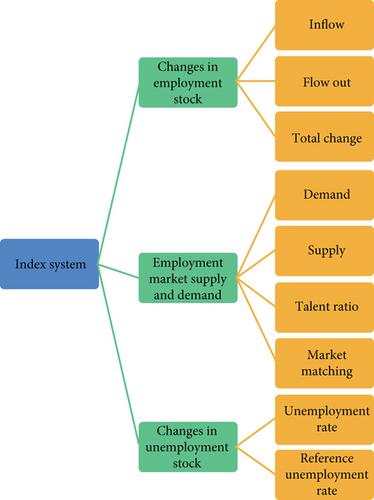
The employment quality of college students is related to the development of education. Increasing investment in education will enhance the development level of higher education and provide a financial basis for cultivating high-quality college students, and the employability of high-quality talents will be correspondingly strong. The factors that affect college students’ employment competitiveness include students’ subjective ability to work. The objective aspects of college students’ employment competitiveness are affected by social development, including development goals and school characteristics. In order to solve the employment problem of graduates, it is more difficult for enterprises to recruit. Improving the employment competitiveness of graduates is a key project to adapt to the reform of higher education and the development of market economy. It is also an important measure to ensure the survival and development of universities.
One of the functions of EPI for college students is to establish a contact intermediary between the market and students and to play the role of employment service for college students through this intermediary. For college students, it can help them broaden their professional caliber according to market needs and establish rational employment expectations [14]. For college graduates, EPI can be used to guide them to grasp employment opportunities reasonably.
2.2. The Calculation of College Students’ EPI
Employment is the greatest livelihood. The purpose of stabilizing growth and protecting market players is to protect employment, that is, to protect people’s livelihood and social stability [15]. With the increase in the number of college graduates, the severe employment situation, and fierce competition, the number of postgraduate applicants is increasing year by year, and the number of postgraduate entrance examinations has surged. In literature [7], the data of talent activity in major cities are compared. Talent activity = the ratio of the number of people with strong job − seeking intention to the talent base. The higher the talent activity, the more talents flow in, and the stronger the attraction of the city to talents (Figure 2).
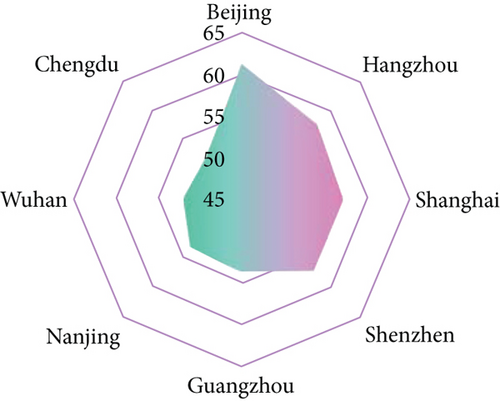
Due to the pressure of work, life, and environment in first-tier cities, talents are moving to new first-tier cities with more comfortable life and less competition. In addition, due to the shortage of land in first-tier cities and the high cost of living, in recent years, major Internet and technology companies have started to move many businesses to new first-tier and second-tier cities for the long-term development of their companies, which has brought a large number of jobs to these cities. There are more and more new opportunities, and at the same time, the housing prices are within the affordable range, so the level of talent activity in these areas is at a high level.
The role of human capital investment is not immediate [16, 17]. Its role can continue to play in a long period of time. Although the knowledge is updated quickly, the cumulative effect of human capital stock is long-lasting. The update is only a further development on the original basis, and human capital investment just adapts to this way. The role of human capital investment in urban competitiveness is often indirect, difficult to quantify, and time-delayed. Its role is generally realized through labor force, scientific and technological progress, and other factors and links.
- (1)
The city provides its own labor force and natural resources
- (2)
The role and status of politicians and administrators are particularly important, and their thoughts and behaviors play a decisive role in the development of urban economy
- (3)
Entrepreneurs have become the core role
- (4)
It is no longer possible to maintain the competitive advantage for a long time by relying solely on entrepreneurs’ adventurous spirit. In this dynamic process, the functions of the four types of human capital are also different, and each stage has a human capital that plays a major role
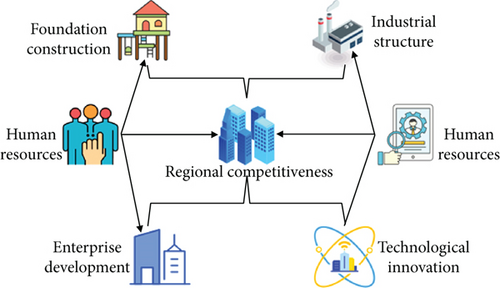
The direct factors, including enterprise development and industrial structure, support each other and restrict each other. Among them, scientific and technological innovation is the internal power of enterprise development, and its role in urban competitiveness should be realized by enterprises. Industrial structure grasps the development direction from a macroperspective, and enterprises are the core of the whole force. The activities of enterprises are related to all aspects of urban development.
Hindex(t) is the benchmark fluctuation index, which takes different values with time; di(t) is the value of the ith index at time t; Wi is the weight of the ith index, which is generally determined by correlation coefficient weight or expert scoring method; N is the number of indicators.
Among them, Egrowth rate is the growth rate of employed population; Eemployed population is the current employment population; ELast employment population is the population in permanent employment.
Among them, U is the long-term unemployment rate index; Fi, Fj is the number of people receiving unemployment insurance for six consecutive months in the base period and the number of people receiving unemployment insurance for six consecutive months in the current period; P is the total number of participants.
In order to facilitate the unity of calculation, all types of indicators are positively processed in this paper. The specific method is as follows:
The value range of correlation coefficient r is [-1,1]. When r⟶1 or − 1 is used, it indicates that the correlation degree is stronger; on the contrary, the correlation coefficient r⟶0 is weaker.
2.3. Optimized Implementation of EPI System
EPI can not only objectively and truly reflect the present situation and trend of employment but also fully show the macroeconomic situation, the relationship between labor supply and demand, and the implementation effect of employment policy [18]. Because the labor transferred from the primary and secondary industries cannot meet the demand of talents in the tertiary industry from skills, knowledge, and other aspects, resulting in the friction of the structure of labor supply and demand, there may be a situation that the supply of labor in the primary and secondary industries exceeds demand, while the supply of labor in the tertiary industry is in short supply.
Employment elasticity is the percentage change of employment quantity corresponding to every percentage change of economic growth. The change of employment elasticity depends on factors such as economic structure and labor cost. The capital investment and labor cost required for a certain amount of labor employment constitute the unit cost of employment. Employment elasticity is related to economic growth and employment growth. Employment elasticity is the ratio between the two growth rates, so a high employment elasticity does not mean that employment is more full. On the contrary, low employment elasticity does not mean that unemployment is more serious. Generally speaking, in the process of economic maturity, the elasticity of employment will gradually decrease. The decreasing employment elasticity indicates that the labor increment required to create an incremental value becomes smaller, which actually means the improvement of labor productivity. If the proportion of labor-intensive economy such as small- and medium-sized enterprises and service industry in the economic structure is large, the proportion of capital is low, the employment cost is relatively low, and the employment elasticity is high.
At present, it is more and more difficult for college graduates to find jobs, and the pressure is increasing. On the one hand, it is related to the rapid growth of the number of college graduates employed; on the other hand, the employment of college graduates is closely related to the socioeconomic situation, industrial structure, and graduates’ own psychology. With the continuous development of social economy, the average per capita income of the people is constantly increasing, and the labor force will first move from the primary industry to the secondary industry. When the per capita national income is further increased, the labor force will move to the tertiary industry as a whole.
Logistic regression in the general sense requires that the dependent variable y has only two values, namely, the binary variable. In fact, the logistic regression model is not limited to the application of binary response variables [19].
For multiclass response variables, that is, the response variables with three or more classes, logistic regression is also applicable as long as the model is slightly improved.
In the formula, p is the probability of graduates’ employment, and 1 − p is the probability of graduates’ nonemployment; a is a constant term; xi is the explanatory variable; bi is the regression coefficient of each explanatory variable; ε is a random error term.
3. Result Analysis
The employment part of the original data in this example comes from the statistical data of the employment situation of fresh graduates of H University Employment Guidance Service Center. After obtaining the original data, strict coding input and verification have been carried out. Therefore, the data quality is reliably guaranteed.
Through the overall analysis of the above comprehensive score, we will further analyze the influence of each dimension on EPI score in detail and summarize the dimension indicators that have important influence on EPI score. Figure 4 shows the EPI scores of college students in 2013-2020 according to dimensional indicators.
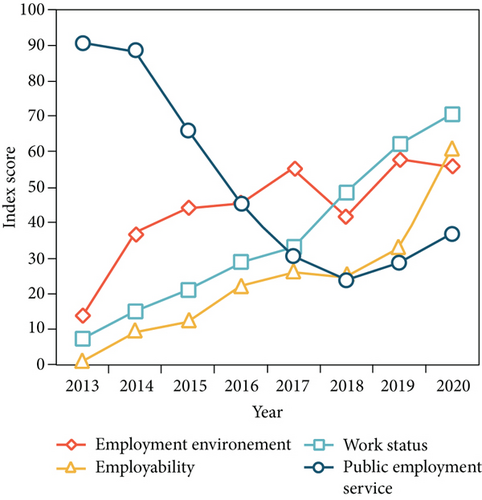
We reflect the unfair employment phenomenon through the income gap; that is, as the income gap between urban and rural residents in H University area is gradually widening, the unfair employment phenomenon will adversely affect the EPI scores of college students. On the other hand, the economic development index shows a tortuous upward trend.
Under normal circumstances, with the development of economy, the GDP created by people should develop in the same direction as the regional economic growth. In terms of social insurance and labor supply and demand, the scores of both show a trend of first increasing and then decreasing. The possible reason for this phenomenon is that the government policy and the social market environment have different demands on the labor force.
The motivating factors that influence graduates’ satisfaction include job satisfaction, job nature, and promotion opportunities. Policy and administration, interpersonal relationship, and personal life are the health care factors that affect graduates’ employment satisfaction. With the expansion of the scope of responsibilities and working face of the talent market, the government should take active policies and measures to strengthen the service of the talent market for college graduates’ job selection and employment, establish and improve the service window specifically for college graduates, collect the demand information of enterprises and institutions for college graduates extensively, and effectively combine it with the employment of college graduates. Figure 5 shows the scores of EPI secondary indicators of college students from 2013 to 2020.
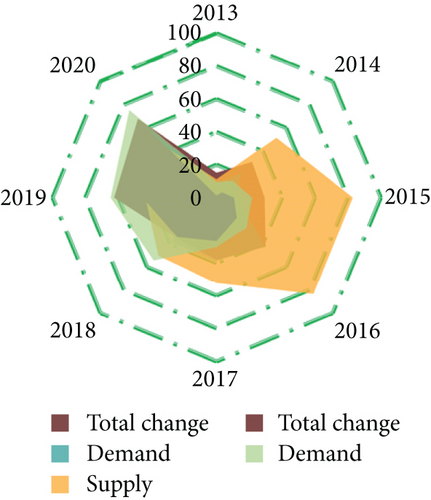
It can be seen that the average rate of talent supply ratio is higher than the rate of demand. The main difference between the high-paid talent market and the labor market is that although the groups needed by the two are the same, the employment tendency of college students is, of course, directed at high-paid jobs. This will lead to the pressure that the supply of some posts far exceeds the demand of posts. However, some post personnel are seriously lacking. The policy comes from the demand of the society for this kind of policy. Therefore, if we want to have an idealized policy, we should not only ensure the process of policy implementation but also ensure the timely formulation of employment policy. In the process of policy implementation, all aspects of policy implementation should give timely information feedback to the problems arising from policy implementation and revise the employment policy. This is the idealized policy.
The main purpose of this logistic regression model is to analyze the influencing factors of university graduates’ reluctance to stay in H city. Therefore, when setting the dummy variable for the explained variable “whether to stay in H city,” we take “stay in H city” as the benchmark variable and set the value to 0, take “not staying in H city” as the observation variable, and set the value to 1. Logistic regression is carried out by SPSS software, and three very insignificant factors, such as salary amount, consumption level, and corresponding position, are eliminated. The regression results are shown in Table 1.
| Explanatory variable | Coefficient of regression | Significant level |
|---|---|---|
| Academic degree | -1.25 | 0.00 |
| Gender | 0.74 | 0.03 |
| Salary level | 2.24 | 0.00 |
| Job prospect | 1.89 | 0.07 |
| Talent policy | 1.04 | 0.001 |
| Economic conditions | 1.01 | 0.05 |
Considering the significance level, among the influencing factors, salary level, educational background, talent policy, and the number of famous enterprises have the greatest influence on staying in H city. Among them, the salary level is the most important factor, and its chi-square test value reaches 60.1%. That is to say, the main factor that graduates do not stay in H city is that the salary level in H city is too low. The correlation coefficient of knowledge of talent policy is 1.04, that is to say, the lack of knowledge of talent policy in H city has caused graduates to be reluctant to stay in H city to some extent.
To some extent, it is also detrimental to career development. Many universities lack professional career guidance teachers, which makes career planning education useless. Most students do not really understand the exact meaning of career planning, and they do not really master the methods and skills of career planning. Most of the plans made are mere formality and lack of practicality, which leads to the failure of career planning to give full play to its due role. This may be the reason why the vocational qualification certificate and career planning have no significant impact on the employment of college graduates.
Table 2 lists the EPI and month-on-month changes of enterprises of different sizes in the first quarter of 2019.
| Scale | Demand number | Number of applicants | EPI increase |
|---|---|---|---|
| Miniature | 27.1% | 28.3% | -0.01% |
| Small-sized | 1.2% | 26.1% | -0.22% |
| Medium-sized | -2.3% | 25.5% | -0.23% |
| Large-scale | 10.5% | 21.1% | -0.15% |
In Table 2, from the month-on-month changes, in terms of demand numbers, the number of medium-sized enterprises decreased, while the number of small enterprises was basically the same, while the number of large and microenterprises increased significantly, with an increase of 10.5% and 27.1%, respectively. In terms of EPI, except for microenterprises, the EPI of enterprises of other sizes increased to a certain extent year-on-year. This may be due to the fact that microenterprises are in the “start-up stage,” and most enterprises have weak market competitiveness and short life cycle, so the employment demand has declined to some extent.
According to the calculation results of the factors of economic conditions, employment factors, and employment policies of large- and medium-sized cities, the scores of the employment monitoring indexes of eight cities in 2020 can be obtained, as shown in Figure 6:
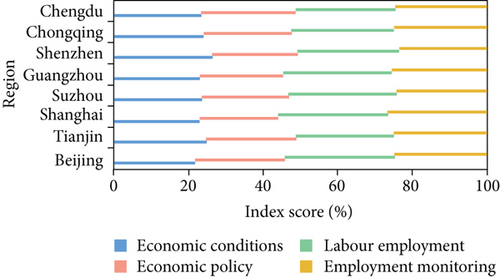
As can be seen from the above table, from the index score, the employment situation in economically developed areas is also better. The score of Shanghai is far lower than that of other first-tier cities, which is due to the low economic condition monitoring index and employment monitoring index of Shanghai. Shanghai’s economic growth slows down in 2020. Due to industrial transformation and upgrading, the contradiction between supply and demand in the labor market is prominent. These factors affect the scores of employment monitoring index in large- and medium-sized cities.
4. Conclusion
Based on the data of a university, this paper uses MLM (multinomial logit model) to optimize the EPI system. Through empirical research, it is found that the system-optimized EPI has the function of evaluating the employment environment of college students. It not only provides the government with macroemployment policies but also provides scientific and effective employment service policies for colleges and universities. As an index system to evaluate and guide college students’ employment, EPI mainly includes employment elasticity and employment effect of college students in different industries. EPI after system optimization can not only reflect the overall trend of the job market but also reflect the structural changes of the job market such as subregion, subindustry, suboccupation, and subenterprise scale. At the same time, we can also get the long-term trend, seasonal characteristics, and periodic changes of the prosperity degree of the job market through the decomposition and analysis of this index, so as to grasp the long-term, short-term, and medium-term prosperity degree changes of the job market more carefully. It provides guidance for employers and job seekers to realize benign interaction, provides intuitive graphic data support for government departments at all levels to understand the dynamics of human resource market, and provides scientific basis for labor and employment management service departments to grasp the overall employment situation and make targeted employment policy decisions.
However, the study still has some limitations. The conclusion and applicability of the research on the employment competitiveness of this paper are conditional. The research on the employment competitiveness of students is not a fatalistic inference in methodology but must recognize the joint action of inevitability and contingency. How to improve and enhance the employment competitiveness of college students is not only the focus of the whole society but also a subject that needs to be further studied in the discipline education reform.
Conflicts of Interest
The authors declare that they have no known competing financial interests or personal relationships that could have appeared to influence the work reported in this paper.
Acknowledgments
This work was supported by the Planning Issues of Philosophy and Social Sciences in Zhejiang Province: Research on Employment Prosperity Index and Analysis Model of College Students in Zhejiang Province under the Background of Normalized Epidemic Prevention and Control (No. 21NDJC050YB).
Open Research
Data Availability
The data used to support the findings of this study are available from the corresponding author upon request.




